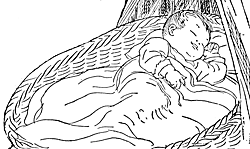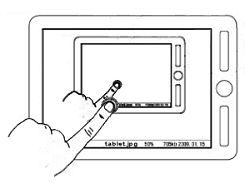 Probably, according to a new paper by Sid Kouider et al. Babies can’t report their own mental states, so they can’t confirm it for us explicitly: and new-borns are regarded by the medical profession as unknowing bags of instinct and reflex, with fond mothers quite deluded in thinking their brand-new offspring recognises anything or smiles at them (it’s just wind, or some random muscular grimace). However Kouider and his associates tracked ERPs (event-related potentials) in the brains of infants at 5, 12, and 15 months and found responses similar to those of adults, albeit slower and weaker, especially in the younger babies. So although few babies are able to pull off the legendary feat of St Nicholas, who apparently uttered a perfectly-articulated prayer immediately on emerging from the womb, they are probably more aware than we may have thought.
Probably, according to a new paper by Sid Kouider et al. Babies can’t report their own mental states, so they can’t confirm it for us explicitly: and new-borns are regarded by the medical profession as unknowing bags of instinct and reflex, with fond mothers quite deluded in thinking their brand-new offspring recognises anything or smiles at them (it’s just wind, or some random muscular grimace). However Kouider and his associates tracked ERPs (event-related potentials) in the brains of infants at 5, 12, and 15 months and found responses similar to those of adults, albeit slower and weaker, especially in the younger babies. So although few babies are able to pull off the legendary feat of St Nicholas, who apparently uttered a perfectly-articulated prayer immediately on emerging from the womb, they are probably more aware than we may have thought.
Kouider has a bit of form on consciousness: last year Trends in Cognitive Sciences carried a dialogue between him and Ned Block. This arose out of a claim by Block that classic experiments by Sperling support the richness of phenomenal consciousness as compared with access consciousness. Block is probably best known for introducing the distinction between phenomenal, or p-consciousness, and access, or a-consciousness, into philosophy of mind. Roughly speaking, we can say that p-consciousness is Hard Problem consciousness, to do with our subjective experience, and a-consciousness is Easy Problem consciousness, the kind that plays a functional role in decision-making and so on.
Sperling, some fifty years ago, showed that subjects shown an array of letters could report only 3 or 4 of them; but when cued to think of a particular line, they were able to report 3 or 4 from that line. They must therefore have had some image of more of the array – probably the whole array – than 3 or 4 items, but could only ever report that many.
Block’s analysis is that the whole array was in phenomenal consciousness, but access consciousness could only ever get 3 to 4 items from it. This is apparently supported by what test subjects tended to say: they often claimed to be conscious of the whole array at the time but not able to recall more than a few of the items (although the Sperling experiments show they could report the quota of items afterwards from any row, indicating that the problem was not really with recall but with access).
Kouider, among others, rejected this view, suggesting instead that the full array is retained, not in phenomenal consciousness, but in unconscious storage. In his view it’s not necessary to invoke phenomenal consciousness, which is an unverifiable addition which we’re better off without. The subjects’ feeling that they had been aware of the whole array can be attributed to a sort of illusion; you don’t notice the absence of things you’re not aware of, any more than you can see whether the refrigerator light goes off when the door is closed.
It’s tempting to think that the dispute is at least aggravated by terminology; everyone agrees that information about the array is retained mentally in a place other than the active forefront of the mind; isn’t the argument merely about whether we call that place phenomenal or un- conscious? That doesn’t seem altogether satisfactory, though, if we take phenomenal consciousness seriously – we are talking about whether the subjects are right or wrong about the contents of their own consciousness, which seems to be a matter of substance. I wonder though, whether there is some unhelpful reification going on – are phenomenal consciousness and the unconscious really two ‘places’? Is it really more a matter of retaining information phenomenally or unconsciously? That might be a slightly more promising perspective, although I also think that mental states are generally a trackless swamp and a dispute with only two alternatives may actually be underselling the problem (could it be kept both unconsciously and phenomenally? Could it be not unconsciously but subconsciously? Could the route from unconscious storage to access consciousness lead via phenomenal consciousness?)
So what about the babies? Is it possible that we are again in an area where what we mean by ‘conscious’ and the way we carve things conceptually is half the problem? It does look a bit like it.
After all (and my apologies to any readers who may have been grinding their teeth in frustration) babies are obviously conscious, aren’t they? The difference between a sleeping baby and one that is awake (which for some common sense values, equals ‘conscious’) is far too salient for any parent to overlook. On the other hand, do babies soliloquise internally? Equally obviously, no, because they don’t have the words to do it with.
But Kouider et al do make it fairly clear that they are specifically concerned with perception, and they make only sensible claims, noting that their results might be relevant, for example, to questions of infant anaesthesia (although it may be difficult to keep the can of phenomenal worms fully sealed on that issue). It is interesting to note the gradual development in speed and intensity which they have uncovered, but by and large I think common sense has been vindicated.

